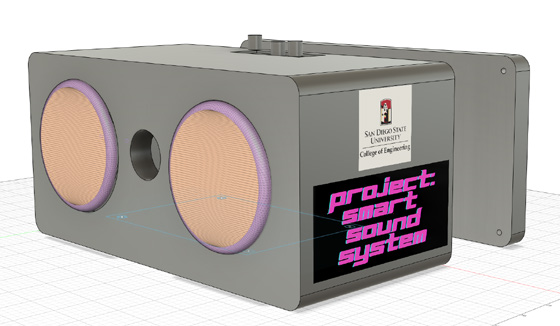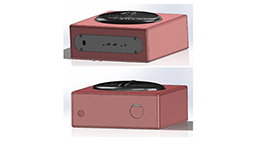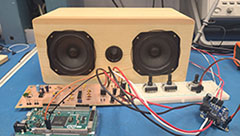DESIGN DAY 2022
Engineering Design Day 2022 showcases innovative design projects the undergraduate Engineering students create throughout their academic year. This event is a combination of the Engineering Senior Design classes in Aerospace Engineering, Civil, Construction & Environmental Engineering, Electrical & Computer Engineering, and Mechanical Engineering.
Engineering Design Day 2022 will be held in Montezuma Hall on May 4, 2022 from 1:30pm - 4:00pm (PST).
Parking Instructions
List of Sponsors
Please visit our College of Engineering Design Day website, which has an archive of all of our Engineering Design Day events.
For previous Electrical & Computer Engineering Design Day projects, please visit:
Design Day 2021
Design Day 2020
Audio Compressor for Hearing Impaired - Team Good Vibes Jonah Andres, Jose Belmar, Ethan Cua, Hugo Rivera Garza, Ninos Younadam
Advisor: Professor Barry Dorr, PE - SDSU
Sponsor: San Diego State University
The Audio Compressor is a device that will aid the elderly or hearing impaired by
helping them listen to the loud and soft passages of their audio. The user can listen
to their audio through speakers or headphones. The user will have the option to choose
different audio compression profiles by using a knob to cycle through each profile
and pressing in the knob to select their profile. Each profile will give the user
the ability to customize the dynamic range of their audio. Additionally, there will
be another knob allowing the user to adjust the gain of the audio. There will be an
LED to indicate to the user if their gain adjustment causes audio clipping. The current
status of the system will be displayed to the user through an LCD display on the audio
compressor’s enclosure.
Automated Chemical Wiping System
(ECE/ME Joint Project)
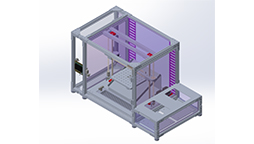
Automated Chemical Wiping System - Team All Suds No Duds Abdulaziz Alrshaid (ECE), Jason Babayev (ECE), Ahmad Bandar (ECE), Jackson Cruise
(ME), Sean Eckstein (ME), Luka Emrashvili (ECE), Lauren Jansen (ME), Jared Meeks (ME),
Kamar Mirza Hussein (ECE), Lori Voong (ME)
Advisors: Dr. Chris Mi (ECE), Dr. Scott Shaffar (ME), Professor Barry Dorr (ECE), Mr. Chris
Cardenas (Masimo), Mr. Austin Pike (Masimo), Mr. Glenn Pohly (Masimo)
Sponsor: Masimo
Devices used in a medical setting must have proper labeling on the exterior casing
to maintain FDA certification. Team All Suds No Duds worked with sponsor Masimo to
create a test device that will be capable of completing up to 100,000 cycles autonomously
to test material degradation of devices. This device consists of multiple subsystems
for linear motion, drainage, wiping, camera, chemical application, and electrical
components.
Automated Pill Dispenser (Phase III)
(ECE/ME Joint Project)
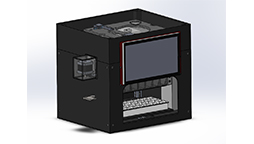
Automated Pill Dispenser (Phase III) - Team Licensed to Pill Courtney Baugh (ME), Julian Ditona (ECE), Kimberly Duron (ECE), Ziyad Elfar (ME),
Max Greiner (ME), Isomiddin Kamilov (ECE), Jason Kassissieh (ME), Mark Le (ECE), Ryan
Shimizu (ECE), Ethan Tallorin (ME)
Advisors: Dr. Sridhar Seshagiri (ECE), Dr. Scott Shaffar (ME), Professor Barry Dorr (ECE),
COL Authur Yeager (QL+), Ms. Annemarie Orr (QL+)
Sponsor: Quality of Life Plus
Team Licensed to Pill designed and manufactured an automated pill dispenser to ease
the process and reduce the need for fine motor skills for patients and caregivers
when dispensing pills into a pill organizer. The pill dispenser is able to distribute
a desired amount of pills to their respective days in both weekly and monthly pill
organizers, can accommodate a variety of pill shapes and sizes, and has an easy to
use, high contrast Graphical User Interface.
Automated Tooling Design for PCB Dispense Application
(ECE/ME Joint Project)

Automated Tooling Design for PCB Dispense Application - Team The Teleporters Abdullah Alani (ME), May Aldhaiea (ECE), Abdallah Alhajeri (ECE), Chad Bicoy (ME),
Denver Chan (ECE), Zachary Chow (ME), Eric Galvan (ME), Aziz Hanna (ECE), Jose Hernandez
(ME), Shervin Shabanpour (ECE)
Advisors: Dr. Scott Shaffar (ME), Mr. David Padgett (Nordson ASYMTEK)
Sponsor: Nordson ASYMTEK
Nordson ASYMTEK dispensing systems provide automation for the semiconductor electronics
market where glues and adhesives are applied to electronic assemblies. These can
be at the board level, wafer level, or at a package level. This project provides
an automated loading, fixturing, heating, and unloading mechanism. The objectives
are to (1) provide a fixed “load” and “unload” position(s) to receive a substrate,
and (2) provide a fixture to hold and heat the substrate during dispensing.
Automated Tray Stacker & De-Stacker (Stax TSD)
(ECE/ME Joint Project)
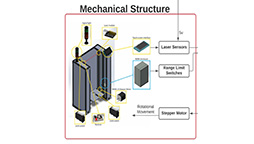
Automated Tray Stacker & De-Stacker - Team Stax Engineering Ali Al-Azmi (ECE), Faakhir Ali (ME), Saud Al-Mutairi (ECE), Ian Estacio (ME), Steven Magayanes (ME),
Karim Omara (ECE), Alejandro Ortiz (ECE), Joel Osuna (ME), Chaitanya Patel (ECE),
Kevin Uy (ME)
Advisors: Dr. Scott Shaffar (ME), Professor Barry Dorr (ECE), Mr. Pratul Singh (Masimo)
Sponsor: Masimo
The Stax Engineering team, along with the sponsorship of Masimo, has developed the
Automated Tray Tacker & De-stacker with the intent to improve the efficiency of Masimo’s
production line. The machine’s design is similar to a 3D printer, where it utilizes
rotational motion and converts it into linear motion through the use of a stepper
motor, microcontroller, and Lead Screw. As a joint ME/ECE team, we were able to develop
an automated mechatronic system that includes sensors, emergency protocols, and a
touchscreen.
Baja Active Suspension System - Team Aztec Baja Active Suspension System (ABASS) Da Chung, Kyle Hill, Benjamin Johnson, Desmond Maxwell, Eric Rosas
Advisor: Professor Barry Dorr, PE - SDSU
Aztec Baja Active Suspension System Team delivers an electrically controlled suspension
system that dynamically responds to variable terrains for the SDSU Baja SAE club competition
race vehicle. Upgrading the mechanical suspensions of the 2019 car, our controller
replaces the same functionalities of the FOX intelligent Quick Switch (iQS) commercial-off-the-shelf
soft, medium, and hard shock settings and adds a custom “Active” mode in response
to wheel position and speed.
Baseball Bat Finishing System
(ECE/ME Joint Project)
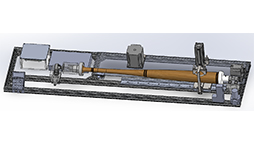
Baseball Bat Finishing System - Team The Sluggineers Abdulwahab Altawheed (ECE), Vincent Chang (ME), Audrey Paris Chuakay (ECE), Anthony
Gugg (ME), Scot Haury (ME), Steven Matti (ECE), Devin Morningstar (ME), Loran Najjar
(ECE), Pat Petel (ME), Brandon Pola (ECE)
Advisors: Dr. Scott Shaffar (ME), Professor Ken Arnold (ECE), Professor Barry Dorr (ECE),
Mr. Victor Escobedo (D&K), Mr. Luciano Silva (Vander Pro Sports), Mr. Miguel Valle
(Vander Pro Sports)
Sponsor: Vander Pro Sports
The objective of this project is to design and fabricate a device that increases the
hardness and surface finish of a wooden, professional league baseball bat by rubbing
along the barrel with a harder material. The design employs a pneumatic cylinder to
apply pressure to the bat barrel and two stepper motors to rotate the bat and move
the pneumatic cylinder along the bat barrel. This system has been designed to operate
at adjustable bat diameters and lengths offered by Vander Pro Sports.
The Sluggineers and their project were featured on the local San Diego KGTV 10News.
To see the news feature, click on SDSU Engineering Students Create a System to Make Baseball Bats Denser
Class D Audio Amplifier - Team Only Electrons Brian Ahlers, Abraham Carranza, Kaitlyn Hamiter, Christopher Johnson, Christopher
Kihano
Advisor: Professor Barry Dorr, PE - SDSU
Sponsor: San Diego State University
HappyTunes is a portable speaker, using a discrete class D audio amplifier developed
by the team. The system is powered by a classic car’s 12 volt auxiliary power port,
placed in a convenient location of the vehicle, used to improve the overall sound
experience, and be easily removed to maintain the original aesthetics of the vehicle.
Furthermore, the device may also be powered via an electrical outlet.
Detection of Unmanned, Autonomous Surface Vessels
(ECE/ME Joint Project)

Detection of Unmanned, Autonomous Surface Vessels - Team Kraken Ahren Kimo Aguinaldo (ECE), Frank Aosman (ECE), Abdulaziz Bandar (ECE), Shane Cooke (ME), Jason Lin (ECE), Jorge Martinez (ME), Kyle
McCoy (ME), Ivan Orozco (ECE), Andrew Preece (ME), Juan Rojas (ME)
Advisors: Dr. Baris Aksanli (ECE), Dr. Scott Shaffar (ME), Professor Barry Dorr (ECE); LCDR
Eric C. Watkins, Jr. (USCG)
Sponsor: Ocean Aero, U.S. Department of Defense NSIN, U.S. Department of Homeland Security
United States Coast Guard
Transnational Criminal Organizations (TCOs) are using autonomous surface vessels to
transport contraband undetected across the Maritime Boundary Line. Such vessels are
difficult to detect, so they pose a threat to national security. Therefore, the United
States Coast Guard requires a fully autonomous vessel under a materials budget of
$700 that is similar to previously seized vessels and is as advanced as possible in
order to determine the best method to detect them before they reach their destination.
Doorbell Alerting System - Team Dorr-Bell Engineering Rashed Abdullah, Rawan Althrwi, Zewei Liu, Jose Perez, Eddie Salazar
Advisor: Professor Barry Dorr, PE - SDSU
Our system is a smart upgrade for conventional doorbell systems that works with the
existing residential doorbell components and provides an easy upgrade. It interfaces
with an existing 16-24V doorbell and its wiring. When a visitor presses the button,
an optocoupler passes a 5V digital signal to an Arduino with Wi-Fi capabilities. When
the button is pressed, it sends an event to a host server that uses IFTTT protocol
to generate an email and send it to a phone app.
Electrically Integrated Linear Mating Cycle Test System
(ECE/ME Joint Project)
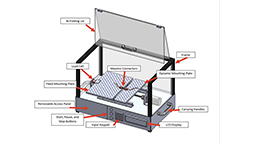
Electrically Integrated Linear Mating Cycle Test System - Team Akula Zub Technologies Fahad Alsahli (ECE), Mark Blair (ECE), Jeffrey Calimbahin (ECE), Thomas Floisand (ME), Andrew Jefferson (ECE), Nereyda Lopez Resendiz (ME), Christine
Maryfield (ME), Belinda Nguyen (ECE), Jake Prittie (ME), Han Tang (ME)
Advisors: Dr. Scott Shaffar (ME), Dr. Hakan Töreyin (ECE), Professor Barry Dorr (ECE), Mr.
Chris Cardenas (Masimo), Mr. Austin Pike (Masimo), Mr. Glenn Pohly (Masimo)
Sponsor: Masimo
Connector Resistance and Force Tester (C.R.A.F.T.) is an electrically integrated linear
mating cycle test system capable of measuring insertion/removal forces and electrical
resistance of connectors of various shapes and sizes. This system was designed for
Masimo, a medical device company focused mainly on noninvasive patient monitoring,
with the purpose of testing their multiple connectors’ lifespan and their mechanical
and electrical properties. C.R.A.F.T. is a benchtop sized, fully enclosed system,
designed with both mechanical and electrical components. With a user-friendly interface,
C.R.A.F.T allows the operator to determine customized parameters for each connector
during setup such as cycle speed, travel distance, and connection time.
Granola Kiosk
(ECE/ME Joint Project)
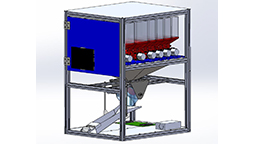
Granola Kiosk - Team Granola Goats Kimo Barrere (ECE), Paris Bee (ME), Claudia Callejas Dominguez (ECE), Adhel AJ Corpuz (ME), Conrado Dela Rosa (ECE), Joe Huang (ECE), Daniel Izarraras (ME),
Xavier Lovato (ME), Zayne Mirza (ME), Evaristo Rodriguez (ECE)
Advisors: Dr. Scott Shaffar (ME), Professor Barry Dorr (ECE), Mr. Dusty Fisk (D&K Engr), Mr.
Wayne Jackson (D&K Engr), Mr. John Reep (D&K Engr)
Sponsor: D&K Engineering
This project involved the design, fabrication and tesing of a consumer, self-serve
granola dispensing kiosk. The design solution takes into consideration the customer’s
ingredient choices as well as the desired serving size. It then uses its control system
to maneuver all the mechanical components responsible for measuring, mixing, and dispensing
the granola. The secondary goal of this project is to provide a modular design that
may be utilized in future kiosks that D&K may be looking to manufacture.
Handy Aztec Digging & Extraction System (HADES)
(ECE/ME Joint Project)
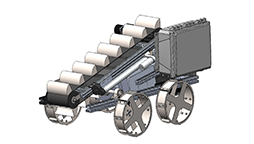
Handy Aztec Digging & Extraction System - Team HADES Sterling Belaire (ME), William (Billy) Bilicki (ME), Alyssa Brunen (ME), Andrew Chung
(ECE), Linda Clark (ME), Nathan de Chambeau (ME), Josh Dolled (ECE), Jaquelyn Fernandez-Iniguez
(ECE), John Paul Edwin Ventura (ECE), Jean Michel Vives (ECE)
Advisors: Dr. Zahra Nili Ahmadabadi (ME), Dr. Sridhar Seshagiri (ECE), Dr. Scott Shaffar (ME),
Professor Barry Dorr (ECE)
Sponsor: NASA, San Diego State University
Team HADES is representing San Diego State University at the NASA Robotic Mining Competition
(RMC) Lunabotics 2022 by designing, building, and operating a lunar mining robot.
The goal of NASA RMC is to find innovative solutions to extract material from beneath
the lunar surface using a partially autonomous robot with a dust-free operation/design.
The competition is an engineering challenge in which students gain experience with
the engineering lifecycle process, from concept development to system closeout.
Hiking Powered Prosthetic
(ECE/ME Joint Project)
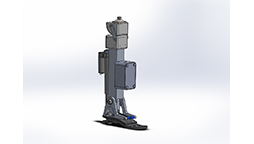
Hiking Powered Prosthetic - Team Tyr Nasser Almarshoud (ECE), Susana Arellano (ME), Dina Batros (ECE), Matthew Blake (ME), Zach Brueggeman (ME), Marc Anthony Do (ME), Garrett Grommes (ME),
Justin Killam (ECE), Jarel-John Macanas (ECE), Sony Shosani (ECE)
Advisors: Dr. Scott Shaffar (ME), Professor Barry Dorr (ECE), Ms. Annemarie Orr (QL+)
Sponsor: Quality of Life Plus
Most current powered prosthetics serve the purpose of assisting the user with their
everyday walking. Our team was challenged to design a more advanced prosthetic capable
of going on long hiking and hunting expeditions in inclement weather. Our prosthetic
uses a linear actuator in series with a spring to provide powered assistance to the
user’s gait, making it easier and more comfortable for them to hike and walk on uneven
terrain.
Inductive Charging for Pool Robots
(ECE/ME Joint Project)

Inductive Charging for Pool Robots - Team Indux Abdulmohsen Alabdulkarim (ECE), Aeron Joshua Gonzalves (ECE), Mohammed Mohammed (ECE),
Uriel Molano (ECE), Paul Nguyen (ME), Truong Nguyen (ME), Rene Orellana (ECE), Alejandro
Ortuno (ME), K'Von Tanner (ME), Shane Wegener (ME)
Advisors: Dr. Chris Mi (ECE), Dr. Scott Shaffar (ME), Professor Barry Dorr (ECE), Mr. Dustin
Borg (Fluidra), Mr. Brian Liss (Fluidra)
Sponsor: Fluidra North America
Current robotic pool cleaners exist as either hard-wired to an external power source
or battery operated with manual periodic charging, similar to current robotic home
vacuums. The project researched inductive charging methods, pool cleaning technologies
and various regulatory and practicality concerns. The team designed and fabricated
a working prototype of an inductive charging system for Fluidra’s robotic pool cleaner.
Integrated Cable Bend Cycle Test System
(ECE/ME Joint Project)

Integrated Cable Bend Cycle Test System - Team 22 Bend Street Abdulwahab Alqurtas (ECE), Kyle Collins (ME), Grace Fraser (ME), Brandon Lipscomb (ME), Joseph Marquez (ECE),
Christopher Martin (ME), Jeremy Minimo (ECE), Alfonso Monroy (ECE), Phummin Rotphan
(ME), Frank Slewa (ECE)
Advisors: Dr. Scott Shaffar (ME), Professor Barry Dorr (ECE), Mr. Desmond Mok (Masimo), Mr.
Glenn Pohly (Masimo), Mr. Jonathan Truesdell (Masimo)
Sponsor: Masimo
The Electrically Integrated Cable Bend Cycle Test System is designed to test the durability
of medical-grade cables manufactured by Masimo. Our device features five independently
controlled motorized workstations to carry out flexion stress tests and comes equipped
with fully automated testing procedures. Key technologies built into the device include:
precision motor control, adjustable workstations coupled with an ergonomic cable mounting
system and continuity detection.
Particle Measurement Test System for Pool Filtration
(ECE/ME Joint Project)

Particle Measurement Test System for Pool Filtration - Team Influunt Ameer Alhelli (ECE), Ahmad Ali (ECE), Nicholas Davis (ME), Jose Maldonado Villarreal (ME), Zachary McGraw (ME), Kevin Nguyen
(ECE), Laith Noeil (ECE), Christopher Torres (ME), Brian Tran (ME), Kenny Truong (ECE)
Advisors: Dr. Scott Shaffar (ME), Professor Barry Dorr (ECE), Ms. Merinda Nugent (Fluidra)
Sponsor: Fluidra North America
To test the quality of filters, Fluidra performs tests in accordance with the NSF
50 standard for pool equipment. For this, the team was tasked with designing a system
capable of measuring the particle size/count in the water at the inlet and outlet
of a filter, be able to draw water from two tanks, measure and throttle the flow rate
in the system, measure the pressure across a filter, read the temperature of the water,
and measure the turbidity (measured in NTUs) at the inlet and outlet of the filter,
all in real-time.
PID Controlled Microwave Press
(ECE/ME Joint Project)
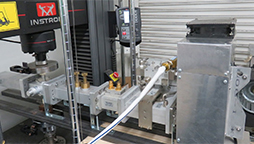
PID Controlled Microwave Press - Team Sintering Engineers Omar Alshatti (ECE), Logan Beltz (ECE), Gabriel Facco Bettinelli (ECE), Dante Gonzalez Corbett (ECE), Aquin
Manners (ME), Christopher Sarabia (ME), Eric Segura (ME), Jimmy Tran (ECE)
Advisors: Dr. Scottt Shaffar (ME), Dr. Elisa Torresani (ME)
Sponsor: SDSU, Powder Technology Laboratory
In support of SDSU materials search, team Sintering Engineers have created a sintering
chamber that includes a Proportional–Integral–Derivative (PID) controller system for
an existing Microwave Press. The PID controller will utilize input data from the materials’
increase in temperature and difference in the emitted and reflected power over time,
to govern the energy emitted from the magnetron. The intention is to flash sinter
a powder based material, under pressure to create more homogeneously transparent material
and progress microwave sintering technology.
RANS Product Update - Team The Abstract Alarmists William Bowling, Raul Palomo, Zachary Tarkowski, Isaiah Webster, Kevin Wuertz
Advisor: Professor Barry Dorr, PE - SDSU
Sponsor: Mr. Dennis Berglund, PE, Priax Corporation
The Roving Alarm Notification System (RANS) is a security system designed to give
nearby roaming personnel up to date location information for designated security zones.
This iteration of the system seeks to upgrade the obsolete components and the memory
storage of the device.
Rapid Deployment Runway Closure System (RDRCS)
(ECE/ME Joint Project)
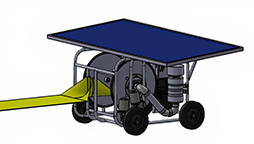
Rapid Deployment Runway Closure System - Team Blockade Brigade Sean Connolly (ECE), Alyssa Elkins (ME), Khalid Nunow (ECE), Jomari Paguia (ECE),
Marc Tanwangco (ECE), Timothy Turner (ME), Nick Wolford (ME), Bianca Yousif (ECE),
Ala Zeidan (ME)
Advisors: Dr. Chris Mi (ECE), Dr. Scott Shaffar (ME), Professor Barry Dorr (ECE), Mr. Phillip
Benham (BAS)
Sponsor: Benham Aviation Services
The Rapid Deployment Runway Closure System is an inflatable system developed to quickly
deploy and retract to prevent the landing of unauthorized aircraft on remote airstrips
by exhibiting the appearance of a barrier. The inflatable is anchored by a ground
stake and an off-the-airstrip housing complex containing the blower, power supply,
and control system. The system was engineered to be operable by a single person and
adhere to airstrip safety protocols.
Seismic System for Detecting Beach Bluff Collapses
(ECE/ME Joint Project)

Seismic System for Detecting Beach Bluff Collapses - Team Cliff Sense Po-Hsien Chen (ME), Eliott Giberson (ME), Nicolas Kano (ME), Kassandra Marquez (ECE),
Adrian Melgoza (ME), George Mirza (ME), Tristan Schultz (ECE), Richard Stoddart (ECE),
Harrison Ward (ECE), Kevin Winchell (ECE)
Advisors: Dr. Christopher Paolini (ECE), Dr. Scott Shaffar (ME), Professor Barry Dorr (ECE)
Sponsor: SDSU Electrical & Computer Engineering
California coastlines have awe inspiring world class beauty, however cliff bluffs
with hidden dangers put public safety at risk. Our solution is to deploy a long range
underground wireless sensor probe network capable of localized real-time event data
processing of: seismic data, tilt changes, temperature and soil conductivity. Our
system is both wireless rechargeable, and has redundant wireless data download pathways
to maximize operational longevity.
Self-Securing Landing Mechanism for VTOL Autonomous Vehicle
(ECE/ME Joint Project)

Self-Securing Landing Mechanism for VTOL Autonomous Vehicle - Team Talon Christopher Bowman (ECE), Charles Kaui (ECE), Nicholas King (ME), Bryce Kirklen (ME),
Cesar Nuno-Banuelos (ECE), Angelo Peck (ECE), Chanthol Phea (ECE), Robert Spiers (ME),
Nathaniel Thomas (ME), Fady Yousif (ECE)
Advisors: Dr. Scott Shaffar (ME), Dr. Junfei Xie (ECE), Professor Barry Dorr (ECE), Mr. James
Down (Northrop Grumman), Mr. Andrew Simmons (Northrop Grumman)
Sponsor: Northrop Grumman
The goal of this project is to create a system which allows a drone upon landing to
autonomously dock with, and be secured to a ground based landing pad. The drone will
include a control system and sensor suite that is able to detect the landing location,
maneuver itself toward, and align itself with the landing pad. The landing pad will
then mechanically secure the drone once the landing procedure is complete. When the
drone is ready to leave the landing pad, the process will happen in reverse and allow
autonomous flight to once again occur.
Smart Sound System - Team Aztec Audio Mubarak Aljadei, Maximillan Guinto, Alexis Llamas Zamora, Nazreth Negash, Lana Pantskalashvili
Advisor: Professor Barry Dorr, PE - SDSU
Sponsor: San Diego State University
The Smart Sound System 555 (SSS-555) is a stereo audio system that will periodically
detect ambient noise levels to automatically adjust the sound levels produced internally
not to exceed a set threshold for volume and only 10-15 dB above the ambient noise
level.The SSS-555 sound system is being developed to deliver stereo quality audio
without the need for excess space and or complexity.
Solar Tri-Generation - Team Solar Tri Generation Dennis Chhoeuk, Zackary Hollingworth, Eduardo Mercado Figueroa, Elise Serrano, Steven Shaaya
Advisor: Dr. Saeed Manshadi - SDSU
Sponsor: Enersion
Enersion is a clean energy start-up with a system called tri-generation where they
provide cooling, heating, and electricity to a customer. To assist their analysis,
we created a GUI that displays input data such as solar availability, electrical and
hot water usage, cooling load, and compares it with the projected energy capabilities
of various sizes of Enersion’s system. Ultimately, a cost of energy upkeep and carbon
footprint analysis is output to help a customer realize the benefits of installing
Enersion’s system.
THT-21 - Team THT-21 Andrew Castillo, Collin Chapman, Maria Del Pilar, Cheryl Hagar, Mata Gomez
Advisor: Dr. Ying-Khai Teh
Sponsor: Mr. Alejandro Mata Alfambra - Alfambra Cigars
Website:
The THT-21, for Tobacco, Humidity and Temperature 2021, is being developed to serve
as a more accurate and dependable technology for monitoring conditions of drying and
fermenting warehouses used on a tobacco farm in Nicaragua. There is a need for this
technology as the current tools being employed are obsolete, and the farm experiences
heavy product losses when conditions fall out of ideal ranges (26-30°C and 80-90%
relative humidity).
USMC Small Ground Sensor
(ECE/ME Joint Project)
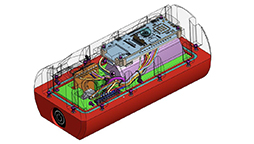
USMC Small Ground Sensor - Team Argus II Mohammed Alfailakawi (ECE), Dwight Anthony Diesmo (ECE), Jhovanna Garcia (ME), Nathan
Mincks (ME), John Pawlak (ME), Marcos Rodriguez (ME), Kaylin Sabado (ME), John Sadiq
(ECE), Nina Truong (ECE), Riley Turner (ECE)
Advisors: Dr. Duy Nguyen (ECE), Dr. Scott Shaffar (ME), Mr. Kevin Demesa (USN), Ms. Cassie
Heyman-Schrum (NSIN)
Sponsor: NSIN, USN, USMC
Marines require a sophisticated understanding of where adversary forces are located
within their battlespace. The USMC small ground sensor project can provide the Marine
ground forces with a deployable compact sensor system that includes audio, visual,
seismic, and GPS data to fully understand an evolving battlespace. The Phase 2 teams
focus is on optimizing the form factor, reliability, durability, weight, and performance.
